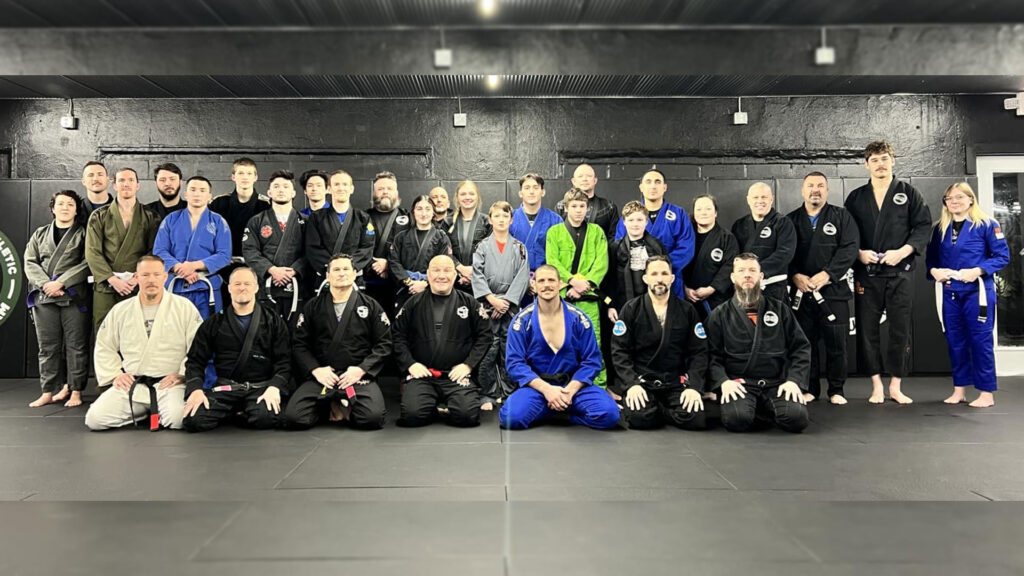Brazilian Jiu-Jitsu (BJJ) is known for its vast array of techniques, which focus on using leverage and technique to control, submit, or neutralize opponents. These techniques can be broadly categorized into several groups:
1. Positions
- Guard: A fundamental position where one person is on their back controlling the opponent with their legs. Variations include:
- Closed Guard: Legs are wrapped around the opponent’s waist.
- Open Guard: Legs are not wrapped but used to control or attack.
- Half Guard: One leg is trapped between the opponent’s legs.
- Mount: One person sits on the opponent’s chest, controlling them from above.
- Side Control: Also known as side mount, where one person lies across the opponent’s chest.
- Back Control: Controlling the opponent from their back, often with hooks (feet) and harness grips (arms).
2. Submissions
- Chokes: Techniques that restrict blood flow or airflow, leading to unconsciousness if the opponent does not tap out.
- Rear Naked Choke (RNC): A choke from the back control position.
- Guillotine Choke: Applied from the front, typically when the opponent’s head is low.
- Triangle Choke: Using the legs to trap the opponent’s neck and one arm.
- Joint Locks: Techniques that hyperextend or manipulate joints.
- Armbar: Hyperextends the elbow joint.
- Kimura: A shoulder lock using a figure-four grip.
- Americana: Another shoulder lock, but with the arm bent differently compared to the Kimura.
- Leg Locks: Various submissions targeting the legs, such as ankle locks, knee bars, and heel hooks.
3. Sweeps
- Techniques used to reverse a position, often from the guard, to move from the bottom to the top position.
- Scissor Sweep: Using the legs to sweep the opponent from closed guard.
- Flower Sweep: A dynamic sweep using momentum to flip the opponent.
- Lumberjack Sweep: A sweep often performed when the opponent stands in the guard.
4. Escapes
- Techniques to get out of inferior positions or submissions.
- Shrimping (Hip Escape): A fundamental movement to create space and escape side control or mount.
- Bridge and Roll: Used to escape mount by bridging and rolling the opponent.
- Technical Stand-Up: A way to safely stand up from the ground while protecting oneself.
5. Takedowns and Throws
- Techniques to bring the opponent to the ground, often borrowed from Judo and wrestling.
- Double Leg Takedown: Grabbing both legs and driving the opponent to the ground.
- Single Leg Takedown: Grabbing one leg and using it to off-balance the opponent.
- Hip Throw (O Goshi): Using the hips to throw the opponent over.
6. Transitions
- Movements to switch between positions smoothly and efficiently.
- Guard Passes: Techniques to move from the opponent’s guard to a more dominant position like side control or mount.
- Torreando Pass: Circling around the legs to pass guard.
- Leg Drag Pass: Dragging the legs to one side to pass.
- Mount Transition: Moving from side control to mount.
- Guard Passes: Techniques to move from the opponent’s guard to a more dominant position like side control or mount.
7. Drills and Conditioning
- Specific exercises to build muscle memory, endurance, and technical proficiency.
- Flow Drills: Repeatedly practicing sequences of movements.
- Positional Sparring: Sparring with a focus on improving specific positions.
BJJ is a dynamic and evolving martial art, with new techniques and variations constantly being developed. The focus on leverage, technique, and adaptability makes it effective for self-defense, sport, and personal development.


